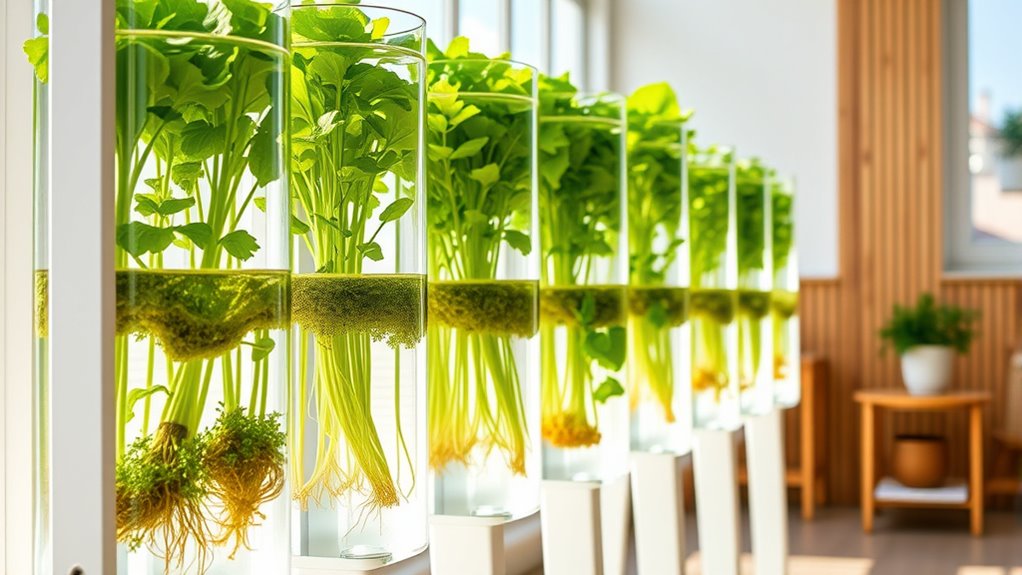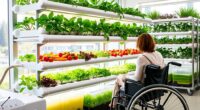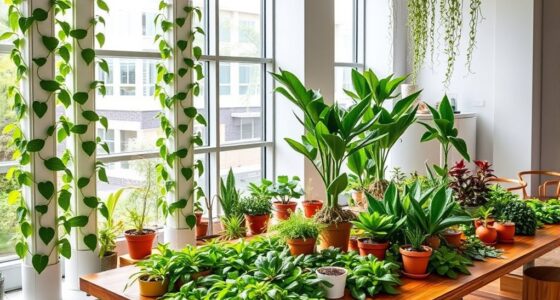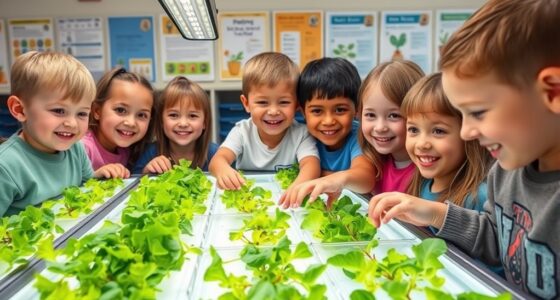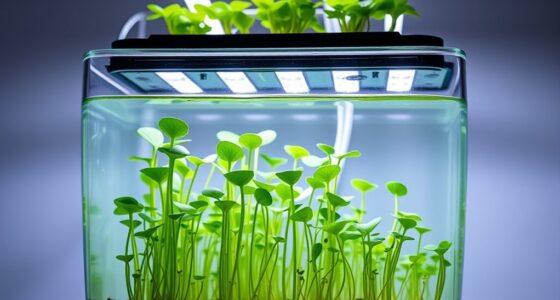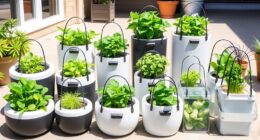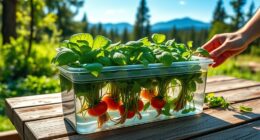Yes, you can grow plants without electricity using the Kratky Method. This simple hydroponic system suspends roots in nutrient-rich water, which naturally oxygenates as the water level drops over time. It requires no pumps, timers, or power sources, making it environmentally friendly and easy to set up. If you want to learn how to maximize this efficient, low-maintenance approach, there’s more to discover about how it works and the plants you can grow.
Key Takeaways
- The Kratky Method is a passive hydroponic system that requires no electricity or pumps.
- It relies on gravity and plant water consumption to maintain nutrient levels and oxygenation.
- Roots are suspended in nutrient-rich water, naturally exposing them to oxygen as water levels drop.
- It is highly water-efficient and suitable for off-grid or low-energy gardening setups.
- The system promotes sustainable, simple, and low-maintenance plant growth without electrical dependence.

The Kratky Method offers a simple, efficient way to grow plants hydroponically without the need for pumps or electricity. Unlike traditional hydroponic systems that rely on continuous water circulation, this method uses a passive setup where the plant roots are suspended in a nutrient-rich water solution. As the plant absorbs the hydroponic nutrients, the water level naturally drops, creating an oxygen-rich environment for the roots. This design minimizes equipment needs and makes it accessible for beginners and experienced growers alike. Plus, it’s highly water-efficient, making it an excellent choice for conserving water while cultivating healthy plants.
The Kratky Method is a simple, water-efficient hydroponic system that needs no pumps or electricity.
When you set up a Kratky system, you fill a container with water and add hydroponic nutrients tailored for your specific plants. These nutrients provide all the essential minerals and elements the plants need to grow strong without soil. Because you’re not using pumps or aerators, the system relies on gravity and the plant’s natural consumption to maintain the water level. Over time, as the plant drinks from the water, the level drops, exposing the roots to air and oxygen, which promotes healthy growth. You simply top up the water and nutrients as needed, keeping an eye on the water level to guarantee the roots stay properly submerged and aerated.
Water conservation is a notable benefit of this method. Since you’re not constantly flushing or circulating water, you minimize waste. The water remains in the container, and you only add more when it drops too low. This means you use less water overall compared to traditional gardening or more complex hydroponic systems. Additionally, because the system doesn’t require electricity, it’s perfect for off-grid locations or anyone looking to reduce energy consumption. You can grow a variety of plants—from leafy greens to herbs—without worrying about power outages or technical malfunctions.
Handling hydroponic nutrients carefully is essential. You want to guarantee your plants receive a balanced nutrient mix, which can be easily adjusted as plants grow. Since the system is straightforward, it encourages you to pay close attention to your plants’ needs and water quality. This hands-on approach not only conserves water but also allows you to learn and adapt your growing methods. The simplicity of the Kratky Method makes it an attractive, eco-friendly option for those interested in sustainable gardening. With just a container, some water, nutrients, and your plants, you’re set to cultivate healthy, thriving plants without electricity, saving resources and effort along the way.
Additionally, understanding the importance of contrast ratio in your setup can help you optimize light conditions for best growth.
Frequently Asked Questions
Can the Kratky Method Be Used for Root Vegetables?
You can try growing root vegetables with the Kratky method, but root vegetable challenges like proper nutrient absorption and space can make it tricky. Since roots need room to expand and access nutrients, a traditional deep container might be better. However, if you carefully manage the water level and nutrient supply, you might successfully grow smaller root vegetables using this passive hydroponic technique.
What Are the Best Crops for Kratky Hydroponics?
You’ll find leafy greens and herbs excel in Kratky hydroponics. These crops thrive in this simple, passive system because they don’t require frequent watering or electricity. Spinach, lettuce, basil, and mint grow quickly and stay healthy with minimal effort. By choosing these crops, you maximize your success and enjoy fresh, flavorful produce all year round. The Kratky method makes growing your favorite greens easy and efficient.
How Long Do Plants Thrive Without Electricity Using This Method?
You can expect your plants to thrive for several weeks without electricity using the Kratky method, but plant longevity depends on proper nutrient management. Over time, nutrient depletion occurs as plants absorb what’s available, so you’ll need to monitor and supplement nutrients to keep them healthy. Since this method relies on passive growth, it’s ideal for short-term cultivation or when you can regularly check and maintain nutrient levels.
Is the Kratky Method Suitable for Indoor Gardening?
Growing with the Kratky method indoors is like having a mini garden inside your home. You’ll find it suitable because it doesn’t require complex lighting or ventilation systems. However, you’ll face lighting challenges, so choosing the right grow lights is essential. You’ll also need to manage nutrients carefully, ensuring your plants get what they need without electricity-powered pumps. With some planning, this method can thrive indoors, giving you fresh greens year-round.
What Maintenance Is Required for a Kratky Setup?
For a Kratky setup, you need minimal maintenance. You should regularly check nutrient management, ensuring your plants get the right balance of nutrients. Container cleaning is essential to prevent algae and pests from thriving, so rinse and sanitize your container periodically. Keep an eye on water levels and plant health, topping up or adjusting nutrients as needed. This simple routine keeps your plants healthy and your system running smoothly.
Conclusion
Imagine growing fresh lettuce on your balcony without any electricity—just water, nutrients, and patience. That’s the beauty of the Kratky Method. Take Sarah, who started her small garden last summer; she’s now harvesting greens weekly without power tools or pumps. If she can do it, so can you. This simple, low-maintenance approach proves you don’t need electricity to enjoy a lush, sustainable garden. Ready to give it a try?
